
PREV ARTICLE
NEXT ARTICLE
FULL ISSUE
PREV FULL ISSUE
NEWMAN SALE X CURRENCY HIGHLIGHTS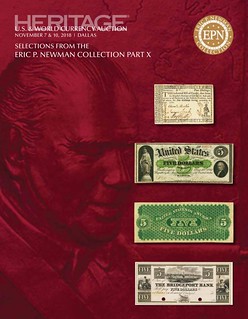
Here are some highlights from the upcoming Heritage sale X of currency from the Eric P. Newman collection. -Editor Lot 20022: Georgia 1762 5 Shillings Native American 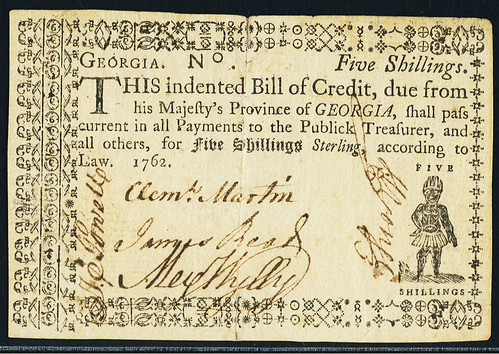 Historically Important 1762 Georgia Native American Vignetted Type Province of Georgia 1762 5 Shillings Native American Fr. GA-40b. PCGS Extremely Fine 40 Apparent. The signatures of Clement Martin, James Read, and Alex Wylly are bold at the center; Powell's is perpendicular at the left, and Yonge's is perpendicular at the right. Despite noted "Edge Splits and Repairs," this is a bright, clean example. The laid paper is very natural and fresh when viewed from each side. Embossed type letters are visible from the back. The antique paper strip repairs are placed delicately at the top and bottom of the blank back. The majority known to us have been restored, often harshly, and do not enjoy this pleasing face appeal. Very underrated and undervalued in this sharp condition, and likely one of the finest extant. This Native American looks more like a Hottentot, a native of South Africa. -Editor To read the complete lot description, see: Lot 20206: $5 1861 St. Louis Demand Note 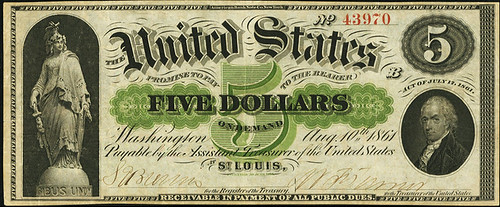 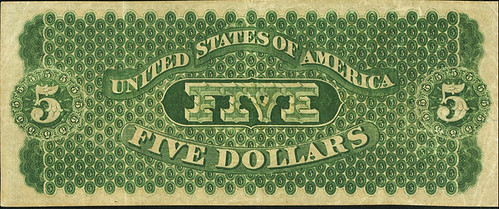 United States of America - Fr. 5 $5 1861 St. Louis Demand Note. PCGS Extremely Fine 40 Apparent. All Demand Notes are rare, but the St. Louis Demand notes are the rarest in the series. There are ten examples of the St. Louis $5 Fr. 5 Demand Note currently listed on the census. This note was from the first material Eric P. Newman ever acquired from the "Colonel" Green Estate. It was among a $1,200 purchase of Missouri paper money (Eric had to borrow $600 as he hadn't yet entered into his partnership with B.G. Johnson.) Amazingly, this purchase included four St. Louis $5 Demand Notes. The present example is the finest of the four and has been in the Newman Collection for over 75 years. It is listed on Eric's original typed inventory (included in this sale catalog) along with the $10 St. Louis Fr. 10 Demand Note (obtained from Wismer in 1939) we sold in Newman Part VIII in for $168,000. American numismatic history at its finest. This purchase was the first of a landmark acquisition of one of the greatest collections of U.S. numismatics ever formed. -Editor To read the complete lot description, see: Lot 20109: Bridgeport Bank $5 Audubon Running Grouse Vignette Note 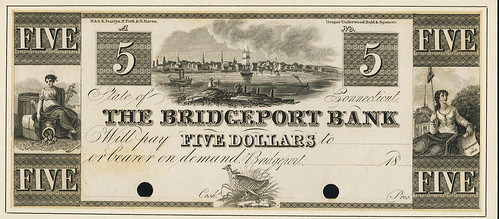 Bridgeport, CT - Bridgeport Bank $5 Audubon Running Grouse Vignette 18__ CT-25 G84. Proof. PCGS Very Choice New 64. Another exciting and very rare offering of a historic Obsolete note type. This proof also features the running grouse adapted after Audubon, using the original Fairman, Draper, Underwood & Co. die, but with a slightly later successor imprint. An India paper proof, affixed to new card. With the dual imprint of N. & S. S. Jocelyn, N. York & N. Haven/Draper, Underwood, Bald & Spencer. The period of this short-lived imprint combination indicates the plates were prepared in approximately 1840 (the first imprint printed the Territory of Florida notes for example, all hand-dated 1830), using the original Fairman, Draper, Underwood & Co. running grouse die at the base. A superbly rendered design with a custom top central vignette of Bridgeport harbor. A couple in the foreground takes in the scene across the tranquil waters, viewing the buildings across the way. A ship appears anchored in the center and a small steamboat at the left is churning water as it prepares to pass. Flanking the vignette are "5" square dies on shaded lathe work. Plenty is seated at the left end and Liberty at the right end; each corner has FIVE on lathe work. The vignette of Audubon's running grouse is at the base. This has an uncertain earlier pedigree (that is, before the American Bank Note Company archives sales) and possibly is the Haxby plate note (if that illustrated a photocopy). Published in the original Peck and Newman article as Figure 8b. A choice example, and a showpiece. The most recent Whitman Encyclopedia, volume 3 illustrates only a partially finished proof of this type. This might be unique as a finished proof, and it is unknown issued. Like all of these Audubon grouse-vignetted items, a key opportunity. Eric's curiosity knew no bounds, leading him at age 99 to discover and document the grouse engraving as a long-lost Audubon print. Something for the numismatist, the bibliophile, and art collector all in one great piece. -Editor To read the complete lot description, see: Lot 20014: 1574 Netherlands Siege of Leiden 5 Stuiver 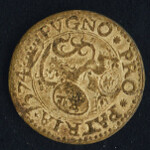  Netherlands - Siege of Leiden 5 Stuiver 1574 P-S101b. PCGS New 62. One of most fascinating historical currencies in the Newman Collection. It may be classified as the earliest European paper money, but it is also properly classified with siege coins. Issued during the early part of the Eighty Years War (1568-1748) when the Spanish were holding siege around Leiden's dikes. Generally, siege coins were struck upon citizens' silver plate and copper, church vessels, or anything that could be put to emergency use for money. In this intriguing case, shredded prayer books and bibles were made into a macerated pulp and formed into pressed cardboard-like sheets. The sheets were than impressed with dies and either struck in collars or trimmed into perfectly round "coins." The face (obverse) has arms and rampant lion at center surrounded with motto PUGNO PRO PATRIA (I fight for my country) and date 1574. The reverse with fancy bordering and inscription LVG/DVNVM/BATAVO/RVM (Leiden in Batavia). This is a top-grade example. Perfectly round and struck-up well on both sides, particularly the back (reverse). There is a short fissure observed on the back as made, but the face looks perfect. Superior to the Neil Shafer "Money of the People" collection example which had some adhered wax from an old seal and realized $3,450 in June 2014. Rarely offered, especially in American sales. This is an important artifact reflecting the tumultuous wars crossing Europe centuries ago and the unusual emergencies created. I had no idea Eric collected these but I guess I'm not surprised. Very rare and historically important. -Editor To read the complete lot description, see: Lot 20111: Government of Norton the First 50 Cents 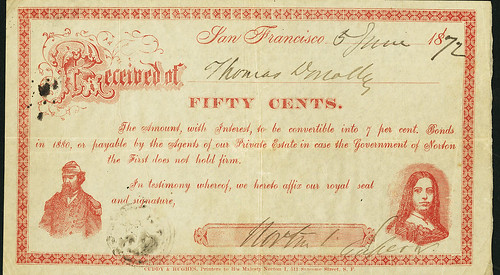 The story of folk hero Joshua A. Norton, who on September 17, 1859, proclaimed himself Norton I, Emperor of the United States and Protector of Mexico, is intriguing. Like countless others, he was drawn to San Francisco in 1849 by the Gold Rush. Although prosperous for a number of years as a commission merchant and entrepreneur, he lost all his money in 1858 after the collapse of the market for rice. Whether his delusion of being emperor was caused by the shock of his insolvency, or perhaps dementia, Norton believed that he was indeed the Emperor of the United States and acted accordingly, issuing "bonds," which he used as currency, and collecting "taxes," in cash by means of personal visits. What is astonishing is that San Francisco's citizens rallied around him with compassionate deference. Joshua Norton died suddenly on January 8, 1880, and his funeral drew tens of thousands of mourners. Interest in his life and legacy was rekindled in 2013 by writer John Lumea. Citing Norton's 1872 proclamation decreeing that "a suspension bridge be built from Oakland Point to Goat Island, and thence to Telegraph Hill," Lumea embarked upon a campaign to name the San Francisco-Oakland Bay Bridge after Emperor Norton (emperorsbridge.org). Norton lives on in film and television episodes, including Bonanza, which are available for viewing on the Newman Numismatic Portal. An extremely rare and early date example of this historic American "currency" issued by the enigmatic Joshua Norton, as "Emperor" of his self-proclaimed domain. Norton's personal popularity in San Francisco allowed him to pass these "convertible bonds" for goods and services, such as his nightly rent at a boarding house, for close to a decade. Twenty years before this note was issued, he was successful and wealthy. His speculation in rice imports led to his financial doom and the lawsuits that followed. Whether he reinvented himself by plan or madness is speculation. However, the Norton I notes are among the most popular Obsolete currency subjects and western paper Americana documents. The Newman Collection contains three different examples, all representing different obligation series. Uniface, lithographed in all red on white rag paper. 20.4 cm x 11.7 cm. The imprint, under the base frame line, is custom to the issuer: CUDDY & HUGHES, Printers to his Majesty Norton I, 511 Sansome Street, S. F. Supposedly, Norton was not charged for the printing costs and this imprint served as an advertisement for the firm. Ornate borders contain the obligations and two vignettes: Norton in uniform at lower left, and a young woman with hair in ringlets at lower right. Along the top, an ornate "Received of" is followed by the line for the recipient of the bond's signature. "San Francisco" and a handwritten date line are to the upper right. The obligation is in five lines: "The Amount with Interest, to be convertible into 7 per cent. Bonds/ in 1880, or payable by the Agents of our Private Estate in case the Government of Norton/ the First does not hold firm./ In testimony whereof, we hereto affix our royal seal / and signature," signed Norton I, Emperor on the shaded block below, with a black ink stamping to the left . Unnumbered. Marckhoff Type 2 (Numismatic Scrapbook, March 1982, pp.671-682). The illustrated example in that article was credited to the California State Historical Society (that dated July 3, 1872). This type was missing from major publicly offered collections from the past decades including Clifford and Ford. It is the first red printed note we have cataloged and is a very distinctive type. The later Norton I types frequently realize in excess of $10,000 each. This is worthy of exceeding that level handily due to its much greater rarity and excellent condition. Emperor Norton was an American original. I've always wanted to own a Norton bond but have had to satisfy myself with reproductions. Historically important and interesting as all get-out. -Editor To read the complete lot description, see: Lot 20068: Continental Currency $30 Contemporary Counterfeit 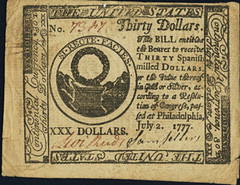 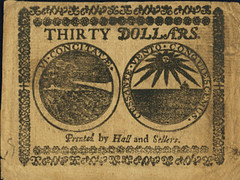 Continental Currency. May 20, 1777 dated July 2, 1777 $30 Newman 1.1 Contemporary Counterfeit Fr. CC-70CF. PCGS About New 50 Apparent. An extremely distinctive counterfeit First United States Notes with a fictitious date. Exceedingly rare and the only example known to us. No. 7327. Printed on thin paper from a single-impression plate, wide margins still present. Diagnostics: This bill has a fictitious date of issue. It was copied from the May 20, 1777, issue. Newman 1.1: Engraved On the face: In the text, the ea and er of Bearer are joined. The i of in touches the line to its left. There is a period rather than a comma after July 2 in the date. On the back: The upper right loop of the P in Printed is completely formed. On the genuine bill, the upper right loop of the P in Printed is mostly missing. The last s in Sellers is tilted slightly to the right. Noted "Edge Tear near LR Corner." The fault is minor. A fascinating example and this would certainly be a prize note in any Continental Currency collection. Contemporary counterfeits circulated right alongside the genuine examples, and are rarities today in their own right. Fascinating item. -Editor To read the complete lot description, see: To read the complete sale catalog on the Newman Portal, see:  Wayne Homren, Editor The Numismatic Bibliomania Society is a non-profit organization promoting numismatic literature. See our web site at coinbooks.org. To submit items for publication in The E-Sylum, write to the Editor at this address: whomren@gmail.com To subscribe go to: https://my.binhost.com/lists/listinfo/esylum All Rights Reserved. NBS Home Page Contact the NBS webmaster 
|